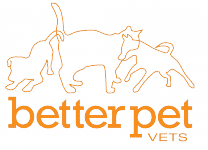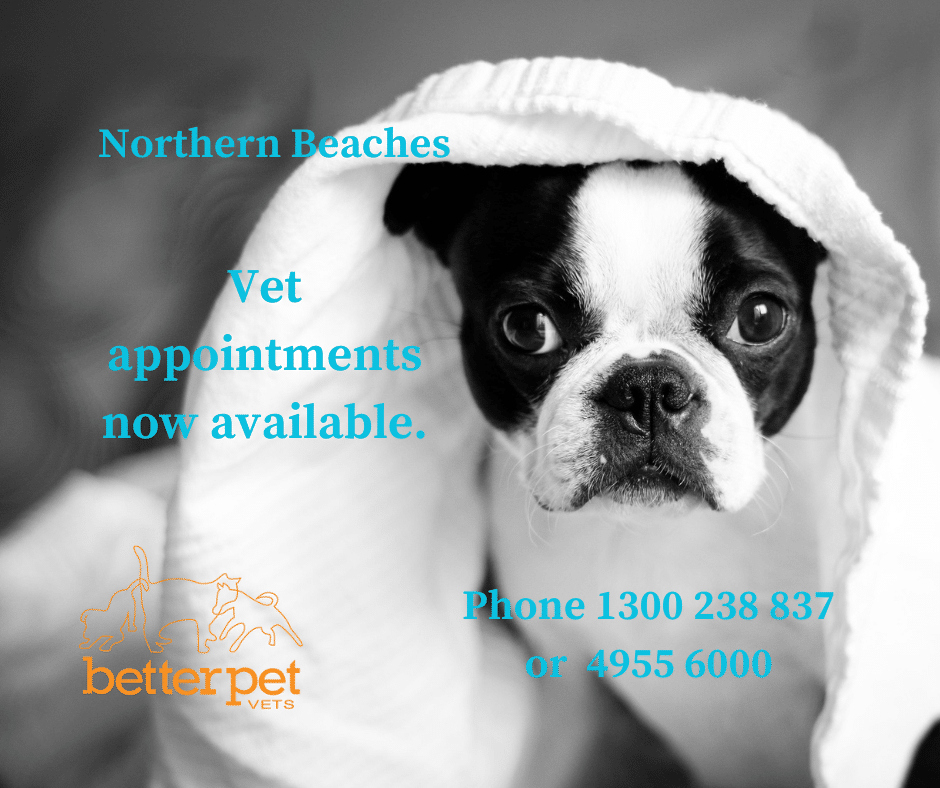We understand that surgery is not an easy experience for you and your pet. At Better Pet Vets our primary goal is to ensure your pet’s surgical procedure is as comfortable and stress-free as possible, with a rapid recovery to a full and active life at home with you – illness and pain free.
But we know that as our client you need a clear understanding of what needs to be done and why, any possible or likely complications and the post-operative care required. We respect your opinions and will happily answer any questions you may have so that you are confident in our surgical care of your pet.
Pre and Postoperative care is critical to the success and comfort of our surgical patients. We believe that since animals can’t tell us that they are in pain, they should be cared for in a way to ensure they are comfortable, pain free, and able to heal
Pain Relief starts before the procedure with analgesia provided even before anaesthesia. For many procedures such as dentistry or orthopaedic procedures we will provide local nerve blocks or epidural anaesthesia to prevent any pain stimulus during surgery. These blocks also allow us to use a lighter anaesthesia for these patients and, in turn, this makes their anaesthetics safer.
Post operatively patients are provided with anti-inflammatory and analgesic medications as appropriate to their procedure.
The surgical technique of experienced and proficient surgeons results in less tissue trauma, bruising, swelling and shorter surgery times. All these factors reduce anaesthetic risk, improve healing, and reduce post operative discomfort or pain.
Patient warming is critical during and after surgery. Maintaining patient temperature during and after anaesthesia increases patient comfort, improves wound healing, decreases pain, decreases infection and speeds anaesthetic recovery. We use heated surgery table mats and IV fluid warmers for each and every patient, and have a constant body temperature monitor during anaesthesia to ensure they remain warm throughout their procedure.
After recovery, patients are wrapped up with warm blankets and their nurse will stay with them until they are awake and fully recovered. Waking up after anaesthesia in an unfamiliar environment to strange sounds and smells is potentially very frightening – so our nurses cuddle and speak gently to them until they know that they are safe and having nothing to be afraid of.
We have high Nurse:Patient ratios to ensure that your pets surgery and anaesthetic is monitored from the time of premedication to the time of recovery. Once recovered we will let you know that the procedure has been completed so you can relax knowing that your pet is safe and sound.
This level of attention to detail for each and every surgical patient is only possible in a fully equipped practice, staffed and trained appropriately. It’s a practice that prides itself on excellence in care for your pet.
Orthopaedic Surgery
Orthopaedic surgery is the diagnosis and treatment of diseases affecting bones, joints, muscles, tendons and ligaments. Lameness, stiffness, being slow to rise, or even behavioural problems (such as irritability or increased resting/sleeping behaviour) are a sign that there may be a problem within a joint or bone. We investigate this by watching your pet’s movement, and a careful complete physical examination of all the limbs and spine. Sometimes, further examination via manipulation under anaesthesia, x-rays and occasionally biopsies are then required to determine the cause of the problem and create a solution. Common orthopaedic problems we treat include:
- Cruciate Ligament Rupture. Dogs have knees that are very similar to ours and can do the same damage to the cranial cruciate ligament and ‘cartilages’ (meniscii). A tear or complete rupture of these structures will lead to pronounced lameness and ongoing arthritis. Surgery to stabilize the joint is the best treatment for almost every dog injured in this way.
- Hip and Elbow Dysplasia. This is a common problem in many large breed dogs. Early diagnosis (before 4-6 months) provides a window of opportunity to correct this condition before arthritis sets in. Surgery may not be the best option if arthritis already exists and the animal is comfortable through rest, gentle exercise, medication and physiotherapy.
- Fractures or Broken Bones are quite common, especially in young animals and after trauma such as motor vehicle accidents or a fall. Casting or Splinting is sometimes appropriate, but often more advanced procedures requiring pins, plates screws and external frames are required to ensure uneventful healing and a complete return to function.
Soft Tissue Surgery
Soft tissue surgery is just that – surgery of just about anything that is not bone! We commonly perform soft tissue surgery on just about all the body systems. Some common surgeries would include:
- Bladder stone removal – surgical removal of stones from the bladder to correct cystitis and blockage of the urinary tract.
- Caesarian section and assisted whelpings – some dogs and some breeds have difficulty giving birth and a caesarian section is performed just like in a human hospital. Always a favourite with the nurses!
- Foreign body removals from the intestinal tract – this rewarding surgery involves the removal (via surgery or endoscopy) of all the amazing things that pets can swallow – string, golf balls, stone fruits, corn cobs to name but a few! If diagnosed and treated early this is a successful surgery but can be life threatening if there is already rupture or severe damage to the intestinal tract.
- Gastric dilatation (bloat) – this is a life threatening condition where the stomach becomes massively dilated and can sometimes twist (volvulus).
- Anal gland flushing or removal – infected or blocked anal glands are a common problem in dogs.
- Soft palate / Blocked Nostril repair – many smaller breed dogs have an overly long soft palate and squashed nostrils. If treated at an early age (6 months to 2 years) this treatment is lifelong and highly successful.
- Skin surgeries would include haemangiomas (huge blood blisters) on the ear and skin biopsies. We also commonly perform lump removals for diagnostic or cancer treatment. Skin flaps and grafts are often required to allow cancers to be removed completely and prevent regrowth or recurrence. (Click here for more information on cancer treatment).
- Wound management is an area of great expertise within the practice – wounds can reach an alarming size after road traffic accidents, dog attacks, or cancer surgery. They must be managed with a combination of pain relief, nutrition, high technology dressings and sometimes advanced surgical techniques to graft or flap skin from other parts of the body.
- Eyes can develop painful ulcers which sometimes need to be debrided (surgically cleaned up) under general anaesthesia.
- Ears can develop painful infections or rupture of the ear drum and these are often managed by gentle but thorough flushing under anaesthesia.
Anaesthesia Care
Our staff of highly trained veterinarians and nurses provide surgical care from 2 sterile operating theatres, using the safest anaesthesia protocols, IV fluids, and equipment like electrocautery to minimize bleeding. All of our surgical patients are treated according to our standards of care which includes a sterile pack of instruments for each and every patient, sterile drapes for each and every patient, and single use only disposables such as scalpel blades and suture material. This standard of sterility and attention to detail means that we do not use routine antibiotic cover for surgical patients. This is better for their health and improves their post operative recovery as their gastrointestinal flora is not disturbed.
All anaesthetised patients have a pre-operative health check, then are provided with analgesic and anxiety reducing medication. An IV cannula is placed in their forearm to allow safe and comfortable IV access throughout their procedure and to allow IV Fluids to be given – this maintains blood pressure, improves tissue perfusion, improves post operative healing and minimizes post operative swelling and pain. It also improves anaesthesia recovery
All patients vital parameters (Heart Rate, Respiratory Rate, Temperature, and Blood Oxygen levels) are continuously monitored and recorded during anaesthesia. Surgical Procedures taking longer than 30 minutes additionally have ECG and Blood Pressure monitoring.
Recovering patients are also closely monitored. The procedure nurse stays with your pet, continuously monitoring and recording heart rate, oxygen saturation and respiratory rate until they are conscious, comforting them if they become anxious or confused during recovery until they are able to stand and walk again.
Better Pet Vets Veterinary Practice has a fully equipped operating theatre including specialised lighting, patient warmers, electrocautery which minimises blood loss at surgery and vital signs monitoring equipment – which monitors heart and respiratory rates, blood oxygenation, blood pressures, body temperature throughout the procedure and continuous ECG to monitor the electrical activity of the heart. The theatre is reserved for sterile surgical procedures only.
We have a separate area for ‘wet’ or non-sterile procedures such as dentistry to ensure the theatre remains clean and sterile.
Desexing Surgery
One of our most common surgical procedures is surgical sterilisation or desexing of your pet. This is a major surgery – particularly in the case of the female – and hopefully the only major surgery your pet will ever have to have in its long, happy, and healthy life with you.
Our standards of care for desexing patients are no less rigorous than those for other major surgeries such as orthopaedics or cancer surgery. If you would like to know more about our surgical standards of care, click here ##
For more information on the desexing procedure itself, please call one of our nurses on 4955 6000 so they can answer any queries you may have.
Postoperative Care
As your pet is being discharged from the practice, we will provide you with detailed information on how to properly care for your pet at home after surgery. We are also happy to answer any questions or concerns that may arise once you get your pet home. Please call us on 4955 6000 if you have any concerns


